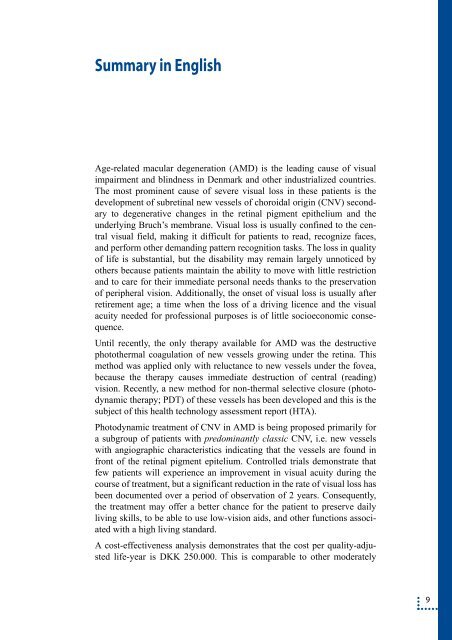Kun elektronisk udgave - Sundhedsstyrelsen
Kun elektronisk udgave - Sundhedsstyrelsen
Kun elektronisk udgave - Sundhedsstyrelsen
Create successful ePaper yourself
Turn your PDF publications into a flip-book with our unique Google optimized e-Paper software.
Summary in EnglishAge-related macular degeneration (AMD) is the leading cause of visualimpairment and blindness in Denmark and other industrialized countries.The most prominent cause of severe visual loss in these patients is thedevelopment of subretinal new vessels of choroidal origin (CNV) secondaryto degenerative changes in the retinal pigment epithelium and theunderlying Bruch’s membrane. Visual loss is usually confined to the centralvisual field, making it difficult for patients to read, recognize faces,and perform other demanding pattern recognition tasks. The loss in qualityof life is substantial, but the disability may remain largely unnoticed byothers because patients maintain the ability to move with little restrictionand to care for their immediate personal needs thanks to the preservationof peripheral vision. Additionally, the onset of visual loss is usually afterretirement age; a time when the loss of a driving licence and the visualacuity needed for professional purposes is of little socioeconomic consequence.Until recently, the only therapy available for AMD was the destructivephotothermal coagulation of new vessels growing under the retina. Thismethod was applied only with reluctance to new vessels under the fovea,because the therapy causes immediate destruction of central (reading)vision. Recently, a new method for non-thermal selective closure (photodynamictherapy; PDT) of these vessels has been developed and this is thesubject of this health technology assessment report (HTA).Photodynamic treatment of CNV in AMD is being proposed primarily fora subgroup of patients with predominantly classic CNV, i.e. new vesselswith angiographic characteristics indicating that the vessels are found infront of the retinal pigment epitelium. Controlled trials demonstrate thatfew patients will experience an improvement in visual acuity during thecourse of treatment, but a significant reduction in the rate of visual loss hasbeen documented over a period of observation of 2 years. Consequently,the treatment may offer a better chance for the patient to preserve dailyliving skills, to be able to use low-vision aids, and other functions associatedwith a high living standard.A cost-effectiveness analysis demonstrates that the cost per quality-adjustedlife-year is DKK 250.000. This is comparable to other moderately9

















